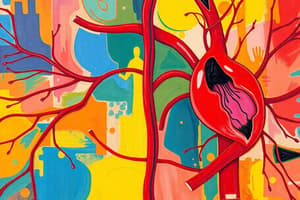Podcast
Questions and Answers
What is the primary function of the circulatory system?
What is the primary function of the circulatory system?
- Regulate body temperature
- Transport waste products (correct)
- Supply tissues with oxygen (correct)
- Produce hormones
Name the two basic types of circulatory systems.
Name the two basic types of circulatory systems.
Open type and close type
The open type circulatory system is more energy-efficient than the close type.
The open type circulatory system is more energy-efficient than the close type.
True (A)
What parts are involved in the human circulatory system?
What parts are involved in the human circulatory system?
What separates the right and left sides of the heart?
What separates the right and left sides of the heart?
Which valve is located between the right atrium and the right ventricle?
Which valve is located between the right atrium and the right ventricle?
Arteries carry blood _____ from the heart.
Arteries carry blood _____ from the heart.
What type of blood is found in veins?
What type of blood is found in veins?
What color is oxygenated blood?
What color is oxygenated blood?
Match the following components of the blood with their roles:
Match the following components of the blood with their roles:
Flashcards
Circulatory System
Circulatory System
Also known as the cardiovascular system, it transports blood, nutrients, and oxygen throughout the body.
Homeostasis
Homeostasis
Maintaining a stable internal environment for survival.
Open Circulatory System
Open Circulatory System
Blood is pumped through open-ended vessels and diffuses into the body cavity.
Closed Circulatory System
Closed Circulatory System
Signup and view all the flashcards
Heart
Heart
Signup and view all the flashcards
Arteries
Arteries
Signup and view all the flashcards
Veins
Veins
Signup and view all the flashcards
Capillaries
Capillaries
Signup and view all the flashcards
Oxygenated Blood
Oxygenated Blood
Signup and view all the flashcards
Deoxygenated Blood
Deoxygenated Blood
Signup and view all the flashcards
Study Notes
Circulatory System Overview
- Known as the transport system or cardiovascular system.
- Comprises blood, blood vessels, and the heart, supplying tissues with oxygen and nutrients.
Objectives of Study
- Compare the two basic types of circulatory systems.
- Describe the parts of the circulatory system and their functions.
- Outline components of blood and their roles in the circulatory system.
Homeostasis
- Maintains a state of balance necessary for survival.
- Circulatory system contributes to homeostasis by:
- Exchanging molecules.
- Controlling the chemical makeup of blood.
- Transporting substances through organs, such as the liver and kidneys.
Types of Circulatory Systems
-
Open Circulatory System:
- Common in invertebrates (e.g., crustaceans, spiders, grasshoppers).
- Blood pumped through open-ended vessels, diffusing out into the body.
- Requires less energy, operates at lower pressure, suitable for organisms with slow metabolism.
-
Closed Circulatory System:
- Found in vertebrates, consists of a heart and a network of vessels.
- Blood is contained within vessels, allowing for higher pressure and faster metabolism.
Parts of the Circulatory System
-
Heart:
- Functions as a double pump, pumping oxygen-poor blood to the lungs and oxygen-rich blood to the body.
- Right side manages pulmonary circuit; left side handles systemic circuit.
- Chambers: upper (atria) and lower (ventricles); septum separates right and left sides.
- Valves prevent backflow, ensuring unidirectional blood flow.
-
Blood Vessels:
- Types include arteries, veins, and capillaries.
- Arteries carry oxygenated blood from the heart, veins return deoxygenated blood to the heart, and capillaries facilitate nutrient and gas exchange.
-
Blood Components:
- Red Blood Cells (RBCs): Transport oxygen.
- White Blood Cells (WBCs): Part of the immune response.
- Platelets: Involved in clotting.
- Plasma: Liquid component containing nutrients, hormones, and waste.
Heart Structure
- Comprised of four chambers: two atria and two ventricles.
- Atria receive blood while ventricles pump blood out.
- Valves:
- Atrioventricular (tricuspid and bicuspid/mitral) and semilunar valves ensure proper circulation.
Blood Types
-
Oxygenated Blood:
- Bright red, rich in oxygen and nutrients, found in arteries.
-
Deoxygenated Blood:
- Dark red, contains carbon dioxide and waste, found in veins.
Blood Vessel Types
-
Arteries:
- Carry blood away from the heart; thick and elastic walls withstand high pressure.
- The aorta is the largest artery; arterioles are smaller arteries leading to capillaries.
-
Veins:
- Return blood to the heart with thinner but wider walls, equipped with one-way valves.
- Venules are the smallest veins.
-
Capillaries:
- Smallest blood vessels, site of nutrient and gas exchange between blood and tissues.
Studying That Suits You
Use AI to generate personalized quizzes and flashcards to suit your learning preferences.




